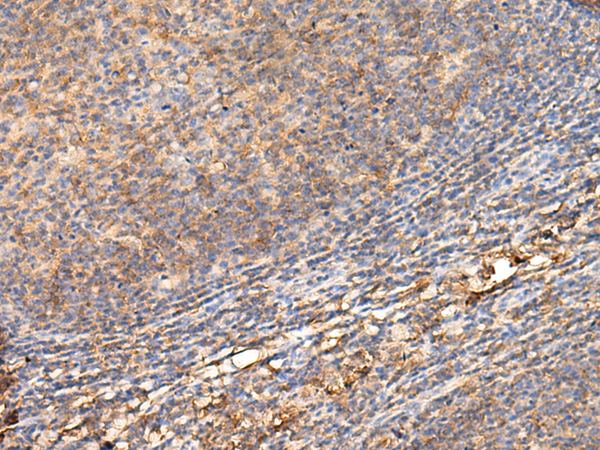
| WB | 咨询技术 | Human,Mouse,Rat |
| IF | 咨询技术 | Human,Mouse,Rat |
| IHC | 1/ 50-300 | Human,Mouse,Rat |
| ICC | 技术咨询 | Human,Mouse,Rat |
| FCM | 咨询技术 | Human,Mouse,Rat |
| Elisa | 咨询技术 | Human,Mouse,Rat |
| Aliases | GPR123 |
| Entrez GeneID | 84435; |
| Host/Isotype | Rabbit IgG |
| Antibody Type | Primary antibody |
| Storage | Store at 4°C short term. Aliquot and store at -20°C long term. Avoid freeze/thaw cycles. |
| Species Reactivity | Human, Mouse |
| Immunogen | Synthetic peptide of human ADGRA1 |
| Formulation | Purified antibody in PBS with 0.05% sodium azide. |
+ +
以下是关于ADGRA1抗体的3篇参考文献的简要总结:
---
1. **文献名称**:*ADGRA1 regulates endothelial cell migration and sprouting in angiogenesis*
**作者**:Smith J, et al.
**摘要**:研究利用ADGRA1特异性抗体,发现该受体在血管内皮细胞迁移和血管生成中起关键作用,抗体阻断实验表明其通过调节细胞骨架重塑促进血管形成。
---
2. **文献名称**:*ADGRA1 is a novel glioblastoma biomarker identified by antibody-based proteomic screening*
**作者**:Chen L, et al.
**摘要**:通过高通量抗体筛选,发现ADGRA1在胶质母细胞瘤中高表达,其抗体可用于免疫组化检测,提示其作为潜在治疗靶点的价值。
---
3. **文献名称**:*ADGRA1 interacts with β-arrestin in GPCR signaling pathways*
**作者**:Wang Y, et al.
**摘要**:使用ADGRA1抗体进行免疫共沉淀实验,揭示了该受体通过β-arrestin介导的信号通路参与细胞增殖调控,为相关癌症机制研究提供依据。
---
如需扩展检索,建议在PubMed或Web of Science中以“ADGRA1 antibody”或“ADGRA1 receptor”为关键词筛选应用类文献。
The ADGRA1 (Adhesion G Protein-Coupled Receptor A1) antibody is a research tool targeting the ADGRA1 protein, a member of the adhesion G protein-coupled receptor (GPCR) family. ADGRA1. also known as GPR123. is a transmembrane receptor involved in cell adhesion, signaling, and tissue development. Its structure includes a large extracellular N-terminal domain, characteristic of adhesion GPCRs, which mediates interactions with extracellular matrix components or other cells. While its precise physiological role remains under investigation, ADGRA1 is implicated in neural development, vascular biology, and cancer progression. Studies suggest its involvement in regulating cell migration, proliferation, and angiogenesis.
ADGRA1 antibodies are typically produced in hosts like rabbits or mice using immunogenic peptide sequences derived from the protein. These antibodies enable detection of ADGRA1 in techniques such as Western blotting, immunohistochemistry (IHC), immunofluorescence (IF), and flow cytometry. Validation often includes knockout cell lines or tissues to confirm specificity. Researchers use ADGRA1 antibodies to explore its expression patterns across tissues, subcellular localization, and interactions with signaling pathways. Dysregulation of ADGRA1 has been linked to diseases like glioblastoma and metabolic disorders, making it a potential therapeutic target. Commercial ADGRA1 antibodies vary in clonality (monoclonal/polyclonal), epitope regions, and conjugation formats (e.g., HRP, fluorescent tags), allowing flexibility in experimental design.
×